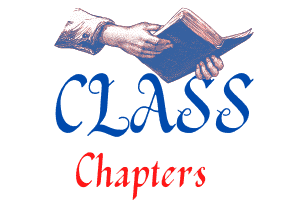We are presenting Class 7 Social Studies Revision Notes for Term-2. These Notes are very useful for students of Class 7 Social Studies. These Revision Notes are prepared as per the new pattern and marking scheme of KVS. These Revision Notes are very useful for teachers of KVS,CBSE schools, and schools following NCERT syllabus.
Class 7 Social Studies Revision Notes
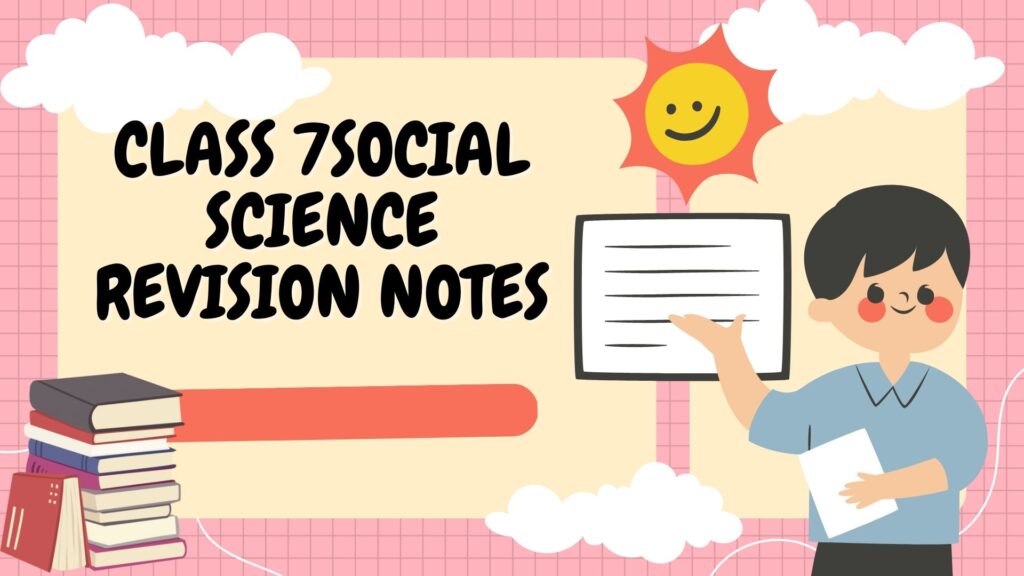
Dear teachers and educators we are presenting Class 7 Social Studies Revision Notes for Term-2. These notes are prepared according to the new syllabus and pattern of KVS. In this question bank, all important questions from Geography – Our Environment Part-2, History -Our Pasts Part -2 and Political Science – Social and Political Life Part-2 will be covered as per the blueprint of the Annual Exam.
Class 7 Social Studies Revision Notes Exam Blueprint
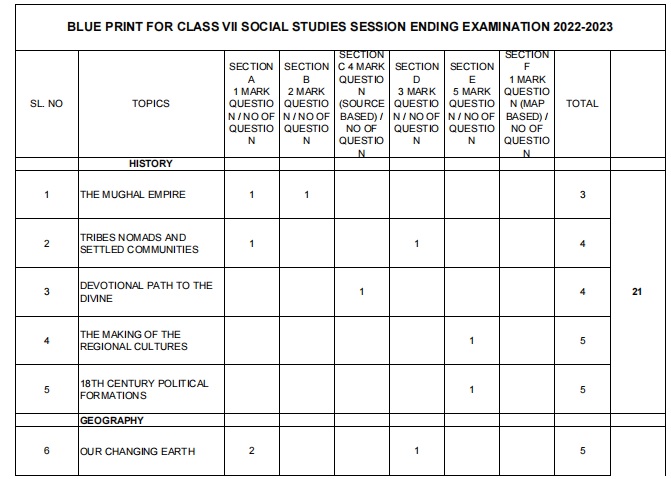
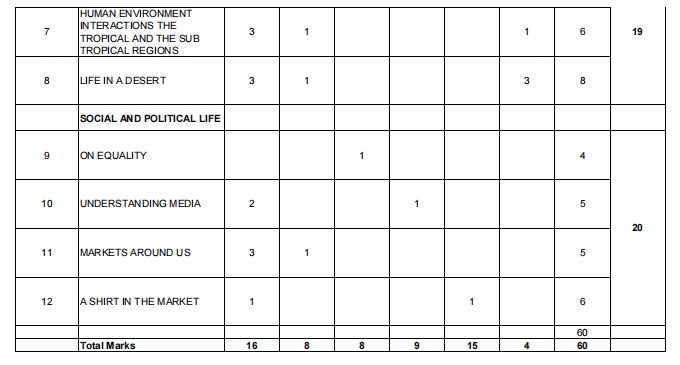
Class 7 Social Studies Revision Notes Exam Syllabus
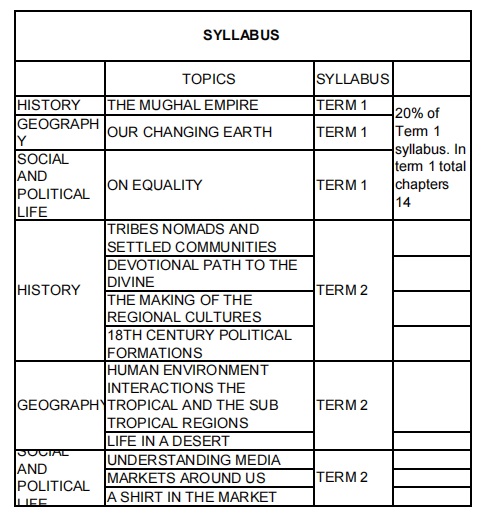
Class 7 Social Studies Revision Notes -Human Environment Interactions (The Tropical and the Subtropical Region)
From this chapter total 5 questions will be asked in the final exam.3 questions –each of 1 mark, 1 question of 2 marks and 1 map related question will be asked. We are providing two important maps related to this chapter.
1-Marks questions Class 7 Social Studies Revision Notes
- Tick the correct answer:
(a) Toucans are a type of
(i) birds (ii) animals (iii) crops. Answer – 1
(b) Manioc is the staple food of
(i) Ganga Basin (ii) Africa (iii) Amazon. Answer -3
(c) Kolkata is located on the river
(i) Orange (ii) Hooghly (iii) Bhagirathi. Answer -2
(d) Deodars and firs are a type of
(i) Coniferous trees (ii) Deciduous trees (iii) Shrubs. Answer -1
(e) Bengal tiger is found in
(i) Mountains (ii) Delta area (iii) Amazon. Answer-2 - Match the following:
(i) Cotton textile (a) Assam
(ii) Maloca (b) Terrace farming
(iii) Piranha (c) Sericulture
(iv) Silk worm (d) Slanting roof
(v) Kaziranga (e) Ganga plain (f) Varanasi (g)Fish
Answer: (i)—(f), (ii)—(d), (iii)—(g), (iv)—(c),(v)—(a)
Question -1 Name the continent in which the Amazon Basin in located. Class 7 Social Studies Revision Notes
Answer -South America.
Question -2 What are the crops grown by the people of the Amazon Basin?
Answer -Crops are grown by the people of Amazon Basin:
Tapioca
Pineapple
Sweet-potatoes
Cassava (manioc)
Maize, coffee, and cocoa are other important crops.
Question-3 Name the birds that you are likely to find in the rain forests of the Amazon.
Answer -Birds: Toucans, Humming Birds, Bird of paradise with their brilliantly coloured plumage, oversized bills.
Question.4 What are the major cities located on the river Ganga? Major Cities located on the banks of River Ganga:
Answer -Dev Prayag, Rishikesh, Haridwar, Kanpur, Allahabad, Varanasi, Patna
Question.5 Where are the one-homed rhinoceros found? Class 7 Social Studies Revision Notes
Answer – In Assam
Question 7. What is susu? What does its presence indicate?
Answer: In the fresh water of River Ganga and River Brahmaputra, a variety of dolphin is found which is locally known as susu. Its presence indicates the health of the river.
Question 8. How and why are terraces built? [V. Imp.]
Answer: Tarraces are built on steep slopes to create flat surfaces on which crops are grown.
Question 9. By what names is the river Brahmaputra known in different places.
Answer: Meghna, Padma, Dehang, Debang, Yamuna, etc.
Question 10. What leads to the pollution of the rivers? [V. Imp.]
Answer: The wastewater from these towns and industries is discharged into the rivers. This leads to the pollution of the rivers.
Map related Questions Class 7 Social Studies Revision Notes One map related Question will be asked from the two maps –
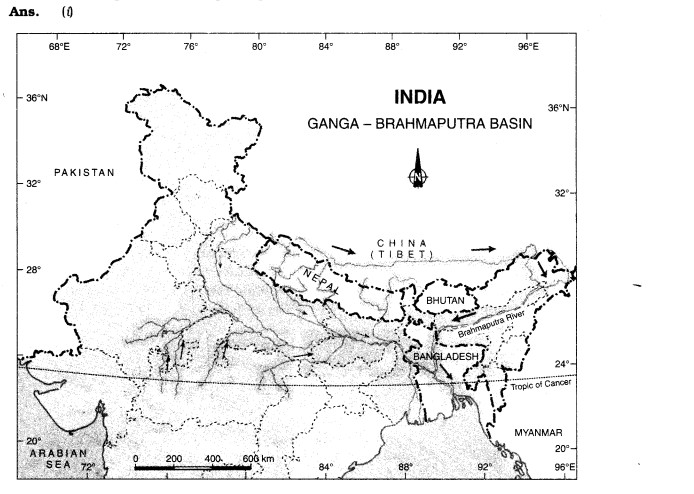

Class 7 Social Science Revision Notes Chapter 10 Life in the Deserts
From this chapter total 7 questions will be asked in the final exam.3 questions –carrying 1 mark each, 1 question carrying 2 marks and 3 map related question will be asked.
1-Marks questions Class 7 Social Studies Revision Notes
- Tick the correct answer:
(i) Sahara is located in which part of Africa?
(a) eastern (b) northern (c) western. Answer- 2
(ii) Sahara is what type of dessert?
(a) cold (b) hot (c) mild. Answer- 2
(iii) The Ladakh desert is mainly inhabited by ………..
(a) Christians and Muslims
(b) Buddhists and Muslims
(c) Christians and Buddhists. Answer- 2
(iv) Deserts are characterized by ……………..
(a) Scanty vegetation (b)heavy precipitation (iii) low evaporation. Answer- 1
(v) Hemis in Ladakh is famous ………………
(a) temple (b) church (c) monastery. Answer- 3
(vi) Egypt is famous for growing
(a) wheat (b) maize (c) cotton. Answer- 3 - Match the following

Question 1. What are the two types of deserts found in the world?
Answer The two types of deserts found in the world are hot deserts and cold deserts.
Question 2. In which continent is the Sahara desert located? Class 7 Social Studies Revision Notes
Answer The Sahara desert is located in Africa.
Question 3. What are the climatic conditions of the Ladakh desert?
Answer- The climate of the Ladakh desert is extremely cold and dry due to its high attitude which varies from about 3,000 m in Kargil to more than 8,000 m in the Karakoram. The air at this attitude is so then that the heat of the sun can be felt intensely. The day temperatures in summer are just above zero degree and the night temperatures are below -30°C. Winters are extremely cold with temperatures below -40°C for most of the time. There is very little rainfall in this region. It is as low as 10 cm every year. The area experiences freezing winds and burning hot sunlight. There is always a chance of sunstroke and frostbite at the same time.
Question 4. What mainly attracts tourists to Ladakh? Class 7 Social Studies Revision Notes
Answer- Ladakh is a famous tourist place. The tourists from within the country and abroad enjoy visiting Buddhist monasteries that dot the Ladakhi landscape with their traditional gompas.
The meadows and glaciers in Ladakh also attract these tourists. The ceremonies and festivities in which the local people keep themselves engaged during winter months are great attractions to the tourists.
Question 5. What type of clothes the people of the Sahara Desert wear?
Answer- The people of the Sahara Desert wear heavy clothes.
Question 6. Name the trees that grow in Ladakh
Answer- Scanty patches of grasses and shrubs, groves of willows and poplars, fruit trees such as apples, apricots and walnuts.
Question 7. How many countries are touched by the Sahara desert? Name them.
Answer: The Sahara desert touches eleven countries—Algeria, Chad, Egypt, Libya, Mali, Mauritania, Morocco, Niger, Sudan, Tunisia, and Western Sahara.
Question 8What are the two characteristic features of a desert? [V. Imp.] Class 7 Social Studies Revision Notes
Answer: The climate of a desert is either very hot and dry or very cold and dry.
The vegetation is sparse.
Question 9 What vegetation is found in the Sahara desert?
Answer: Vegetation in the Sahara desert is comprised of cactus, date, palms, and acacia. Green islands with date palms can be seen near the oases.
Question 10 Why is there little rainfall in the Ladakh desert? [Imp.]
Answer: It is because the Ladakh desert lies in the rain shadow of the Himalayas.
Question 11. Name the birds which are common in the Ladakh desert. Class 7 Social Studies Revision Notes
Answer: Robias, redstarts, Tibetan snowcock, raven and hoopoe.
Question 12. What is the use of the hair of the sheep and goat in the cold desert of Ladak?
Answer: The hair of the sheep and goat is used to make woollens.
Question 13 . Name the four passes which Manali-Leh highway crosses.
Answer: Rohtang La, Lungalacha La, Baralacha La and Tanglang La.
Map related Questions Class 7 Social Studies Revision Notes –Three map related Questions will be asked from the two maps
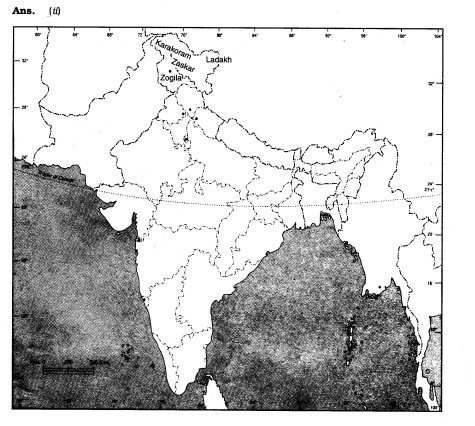
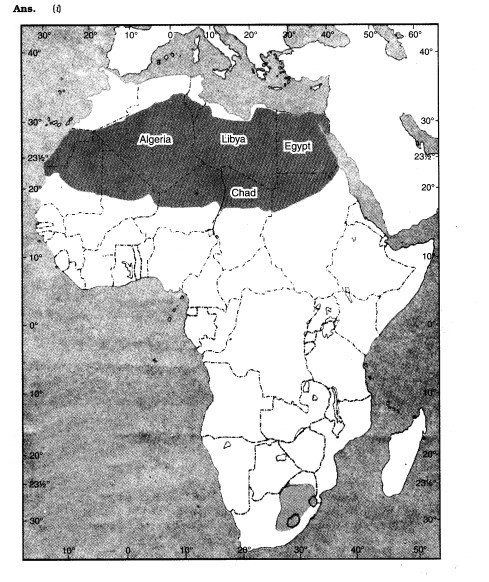
Class 7 Social Studies Revision Notes The Mughal Empire
From this chapter total 2 questions will be covered in the final exam.1 question –carrying 1 mark, 1 question carrying 2 marks.
1-Marks questions Class 7 Social Studies Revision Notes
Match the following-
Mansab – Rank
Mongol – Uzbeg
Sisodiya Rajput – Mewar
Rathor Rajput – Marwar
Nur Jahan – Jahangir
Subadar – Governor
. Fill in the blanks: Class 7 Social Studies Revision Notes
1. The capital of Mirza Hakim, Akbar’s half-bro:, was …………………( Kabul)
2. The five Deccan Sultanate were Berar, Khandesh, Ahmadnagar, (Bijapur, Golconda)
3. If zat determined a mansabdar’s rank and salary, sewer indicated his………(number of horses maintained)
4.Abul Faze, Akbar’s friend and counselor, helped him frame the idea of …………. so that he could govern a society composed of many religions, cultures, and castes. (Administration)
2-Marks Questions Class 7 Social Studies Revision Notes
- Why was it a difficult task for rulers of the Middle Ages to rule the Indian subcontinent? Class 7 Social Studies Revision Notes
Answer: It was because people of diverse backgrounds and cultures lived here. - Who was Genghis Khan?
Answer: He was the ruler of the Mongol tribes, China and Central Asia. - Who was Babur?
Answer: He was the first Mughal emperor and reigned from 1526 to 1530 - Name the battlefield where Ibrahim Lodi was defeated by Babur?
Answer: Panipat. - To whom did Babur defeat at Chanderi?[V- Imp.] Class 7 Social Studies Revision Notes
Answer: Babur defeated the Rajputs at Chanderi - What forced Hwnayun to flee to Iran?
Answer: After being defeated by Sher Khan at Chausa in 1539 and Kanauj in 1540 Humayun fled to Iran. - At what age did Akbar become the emperor of the Mughal Empire?
Answer: Akbar became the emperor of the Mughal Empire at the age of 13. - Who was the regent of Akbar?
Answer: Bairam Khan. - How is Prince Khurram better known as in Indian History? Class 7 Social Studies Revision Notes
Answer: Price Khurram is better known as Emperor Shah Jahan in Indian History.
1o. Who was victorious in the conflict over succession amongst Shah Jahan’s sons?
Answer: Aurangzeb was victorious. - Who fought guerrilla warfare?
Answer: The Marathas fought guerrilla warfare. - What do you mean by the rule of primogeniture? [V. Imp.]
Answer: Under the rule of primogeniture the eldest son inherited his father’s estate. - What was the Timurid custom of coparcenary inheritance? [Imp.]
Answer: It was a division of the inheritance amongst all the sons. - What qualities of the Mughals enabled them to extend their influence over many kings and chieftains? [V. Imp.]
Answer: The careful balance between defeating but not humiliating their opponents enabled the Mughals to extend their influence over many kings and chieftains. is.
15 What does the term mansabdar refer to?
Answer: The term mansabdar refers to an individual who holds a mansab, te. a position or rank. - What was zat? Class 7 Social Studies Revision Notes
Answer: Mansabdar’s rank and salary were determined by a numerical value called zat The higher the zat, the more prestigious was the noble’s position in the court. - What was jagir?
Answer: Mansabdars received their salaries as revenue assignments known as jagirs. - What was zabt?
Ans. It was the revenue collected on the basis of the schedule of revenue rates for individuals crops. - With whom did Akbar hold a discussion on religion?
Answer: Akbar held discussions on religion with the Ulama, Brahmanas, Jesuit priests who were Roman Catholics, and Zoroastrians. - When did Mehrunnisa receive the title of Nur Jahan?
Answer: After Mehrunnisa got married to Emperor Jahangir, in 1611 she received the title of Nur Jahan. - What power did the nobles exercise during Akbar’s reign?
Answer: During Akbar’s reign the nobles commanded large armies and had access to large amounts of revenue. - What were the central provinces under the control of the Mughals?
Answer: Panipat, Lahore, Delhi, Agra, Mathura, Amber, Ajmer, Fatehpur Sikri, Chittor, Ranthambhore and Allahabad. - What were the relationships between the mansabdar and the jagir? Class 7 Social Studies Revision Notes
Answer:Relationship between the mansabdar and the jagir:
1.Mansabdars were those who joined Mughal service.
2.Jagirs were the salaries of the mansabdars in the form of revenue assignments.
3.It means mansabdars received jagirs as their salaries. Hence, mansabdars depended upon jagirs for their livelihood. - What was the role of the zamindar in Mughal administration?
Answer: Zamtndars were powerful local chieftains appointed by the Mughal rulers. They exercised great influence and power. They collected taxes from the peasants and gave them to the Mughal emperor. Thus, they played the role of intermediaries. In some areas the zamindars became more powerful. The exploitation by Mughal administrators made them to rebellion. They got support from the peasants in rebelling against the Mughal authority. - How were the debates with religious scholars important in the formation of Akbar’s ideas on governance?
Answer:
In the 1570’s at Fatehpur Sikri Akbar started discussions on religion with people of different faiths. There were ulemas, Brahmanas, Jesuit Catholic priests and Zoroastrians. - These discussions took place in Ibadat Khana. These were about social and religious customs.
- These interactions made him realise that religious scholars are bigots. They emphasize rituals and dogma.
- Their teachings create divisions in society. This led to the idea of Sulh-i-Kul or ‘Universal peace’.
- Why did the Mughals emphasise their Timurid and not their Mongol descent? Class 7 Social Studies Revision Notes
Answer: The Mughals were descendants of two great lineages of rulers. From their mother’s side they were descendants of Genghis Khan, ruler of the Mongol tribes. From their father’s side they were the successors of Timur, the ruler of Iran, Iraq and modern-day Turkey. However, the Mughals did not like to be called Mongol because Mongol’s especially Genghis Khan’s, memory was associated with the massacre of innumerable people. It was also linked with the Uzbegs, their Mongol competitors. On the other hand, the Mughals were proud of their Timurid ancestry, because it achieved good name in the history.
Class 7 Social Studies Revision Notes Tribes, Nomads And Settled Communities
From this chapter total 2 questions will be covered in the final exam.1 question –carrying 1 mark, 1 question carrying 3 marks.
1-Marks questions Class 7 Social Studies Revision Notes
1.Match the following:
Garh – Chaurasi
Tanda – Caravan
Labourer – Paik
Clan – Khel
Sib Singh – Ahom State
Durgawati – Garha Katanga
2.Fill in the blanks:Class 7 Social Studies Revision Notes
1.The new castes emerging within vamas were called……… jatis
2.……… were historical works written by the Ahoms. ——- Buraryis
3.The…….. mentions that Garha Katanga had 70,000 villages. ——- Akbar Nama
4.As tribal stales became bigger and stronger they gave land grants to………….. .. temples, Brahmanas.
- State whether true or false: Class 7 Social Studies Revision Notes
(a) Tribal societies had rich oral traditions. T
(b) There were no tribal communities in the north-western part of the subcontinent. F
(c) The Chaurasi in Gond states contained several cities. F
(d) The Bhils lived in the north-eastern part of the sub-continent. F
- Describe the beliefs and practices of the Nathpanthis, Siddhas, and Yogis. Class 7 Social Studies Revision Notes
Answer: Beliefs and Practices of the Nathpanthis, Siddhas, and Yogis
Criticism of ritual and other aspects of conventional religion.
Renunciation of the world.
Path of salvation in meditation on the formless.
Ultimate reality and realisation of oneness.
Intense training of mind and body through practices like yogasanas, breathing exercises, and meditation. - What were the major ideas expressed by Kabir? How did he express these? Class 7 Social Studies Revision Notes
Answer: Major ideas expressed by Kabir and his way of expressing them:
Rejection of orthodox religion and religious traditions.
Religion was is accessible to all.
Criticism of all external worship of Brahmanical Hinduism and Islam
No caste system.
Belief in formless God.
Bhakti and devotion is the only path of salvation.
He expressed his ideas through couplets. - What were the major beliefs and practices of the Sufis? Class 7 Social Studies Revision Notes
Answer: Sufis were Muslim mystics. They rejected outward religiosity and gave emphasis on love and devotion to God. They inspired people to be compassionate towards all fellow human beings.
They rejected idol worship and considerably simplified rituals of worship into collective prayers.
They believed that the heart can be trained to look at the world in a different way.
They developed elaborate methods of training using zikr, meaning chanting of a name or sacred formula, contemplation, sama Le. singing, raqs, Le. dancing, discussion of parables, breath control etc. under the guidance of a master called pir. - Why do you think many teachers rejected prevalent religious beliefs and practices? Class 7 Social Studies Revision Notes
Answer:Yes, many teachers rejected prevalent religious beliefs and practices because they had numerous shortcomings and they promoted division in society. - What were the major teachings of Baba Guru Nanak?
Answer: Major Teachings of Baba Guru Nanak
Worship of one God.
Irrelevance of caste, creed, and gender for attaining liberation.
The pursuit of active life with a strong sense of social commitment.
Nam, the dam, is the major essence of his teachings.
Nam-japna, kirt-kama, and vand Chakhna basis of right belief, and worship, honest living and helping others.
The idea of equality.
- For either the Virashaivas or the saints of Maharashtra, discuss their attitude towards caste. Class 7 Social Studies Revision Notes
Answer: Attitude of the Virashaivas towards caste :
They believed in the equality of all human beings. They were against Brahmanical ideas about caste and the treatment of women. They wished for a society where people of all backgrounds could live in harmony without any feelings of high and low, rich and poor. - Why do you think ordinary people preserved the memory of Mirabai?
Answer: Mirabai was a Rajput princess married into the royal family of Mewar. But she had no interest in the worldly affair. She was an ardent devotee of Krishna and wanted to devote her time to the worship of her lord. She had no belief in princely status and other norms of high-class society. Her devotion to her deity was supreme. Hence, she left the royal palace and began to lend. Simple life with ordinary people.
Class 7 Social Studies Revision Notes The Making Of Regional Cultures
1. What are the Important architectural features of the temples of Bengal? Class 7 Social Studies Revision Notes
Answer:Architectural features of the temples of Bengal:
1. Double roofed or dochala, four roofed (chauchala).
2. Comparative more complex-four roofed structures-four triangular roofs placed on four walls moved up to coverage on curved line or a point.
3. Built on a square platform.
4. Interior plain.
5. Outer walls decorated with paintings, ornamental tiles or terracotta tablets.
2. Why did minstrels proclaim the achievements of heroes? Class 7 Social Studies Revision Notes
Answer: Minstrels used to recite poems and songs which depicted the stories of the ” Rajputs’ heroic deeds. By reciting such poems and songs these minstrels inspired others to follow the examples of Rajputs. Ordinary people were also attracted by these stories.
3. Why do we know much more about the cultural practices of rulers than about those of ordinary people?
Answer: We know much more about the cultural practices of rulers than about those of ordinary people because the ordinary people followed the cultural practices adopted by their kings/emperors. Moreover people had faith in their rulers. They could not adopt other cultural practices which their rulers did not practice.
4. Why did conquerors try to control the temple of Jagannatha at Puri? Class 7 Social Studies Revision Notes
Answer: The temple of Jagannatha at Puri gained importance as a centre of pilgrimage. Its authority in social and political matters also increased. Hence, conquerors tried to establish control over the temple. They felt that this would make their rule acceptable to the local people.
5. Why were temples built in Bengal? Class 7 Social Studies Revision Notes
.
Answer:
Temples were built in Bengal because of the following reasons:
1. Increase in religious faith.
2. Mosques had already been built.
3. Powerful people wanted to demonstrate their power and proclaim their piety.
4. ‘Low’ people also participated in the temple building.
5. New economic opportunities to people also helped in temple setting up.
6. Support of Brahmanas to get idols placed in temples from huts
6. Describe the most important features of the culture of your region, focussing on buildings, performing arts, and painting.
Answer: I live in Delhi. Right from the beginning, it has been a land of mixed cultures. In old days, it was invaded by a number of foreign rulers. Some of them stayed here for some time and some settle down permanently. They all affected its culture, language, religion, society, architecture, art and painting. Still we have buildings and monuments built by Mughal emperors, slave emperors, Rajput rulers and many more. We have temples, mosques and many other such places constructed by different rulers. Differences of cultures can still be seen in the areas of old Delhi and new Delhi.
7. Do you use different languages for (a) speaking, (b) reading, (c) writing? Find out about one major composition in language that you use and discuss why you find it interesting.
Answer:
(a) For speaking I use Hindi and Punjabi.
(b) For reading I use Hindi and English.
(c) For writing I use Hindi and English.
Thus, I use different languages for speaking, reading and writing.
8. Mention the role of the Chercis in the development of Malayalam. [V. Imp.]
Answer: The Chera kingdom of Mahodayapuram was established in the ninth century in the south-western part of the peninsula, part of present-day Kerala. It is likely that Malayalam was spoken in this area. The rulers introduced the Malayalam language and script in their inscriptions.
9. How did the Cheras draw upon Sanskritic traditions?
Answer: The temple theatre of Kerala borrowed stories from the Sanskrit epics. The first literary works in Malayalam, dated to about the 12t.h century, are directly indebted to Sanskrit. The Lilatilakam, a fourteenth-century text, dealt with grammar and poetics and was composed in Manipravalam – literally, ‘diamonds and corals’ referring to the two languages namely Sanskrit and the regional language.
10. How did regional cultures evolve? [V. Imp.]
Answer: Regional cultures today are often the product of complex processes of intermixing of local traditions with ideas from other parts of the sub-continent. Some traditions appear specific to some regions, others seem to be similar across regions and yet others derive from older practices in a particular area, but take a new form in other regions.
11. How are women depicted in the stories about Rajput heroes? Class 7 Social Studies Revision Notes
Answer: Sometimes these stories depict women as the cause for conflict, as men fought with one another to either win or protect them (women). Women are also depicted as following their heroic husbands in both life and death. We are familiar with the stories about the practice of sati or the immolation of widows on the funeral pyre of their husbands. So. those who followed the heroic ideal often had to pay for it with their lives.
12. Mention all the six dance forms that are recognised as classical.
Answer: Six classical dances are :
• Kathak (North India)
• Bharatnatyam (Tamil Nadu)
• Kathakali (Kerala)
• Odissi (Orissa)
• Kuchipudi (Andhra Pradesh)
• Manipuri (Manipur).
Class 7 Social Studies Revision Notes Eighteenth-Century Political Formations
From this chapter total 1 question of 5 marks will be asked in the final exam.
1. Why did the Nawab of Awadh and Bengal try to do away with the jagirdari system? Class 7 Social Studies Revision Notes
Answer:Nawabs of Awadh and Bengal tried to do away with the jagirdari system because:
1.They were suspicious of this system that they inherited.
2.Their methods of tax collection were different, they hired “revenue farmers to collect the taxes”.
3.They used practice of Ijaradari rather than jagirdari.
4.They wanted to expand and receive land as security against loans.
5.They knew the loopholes of the system and that how jagirdars become powerful if not checked in time.
2. How were the Sikhs organised in the eighteenth century? Class 7 Social Studies Revision Notes
Answer: During the 17th century the Sikhs got organised into a political community. This led to the regional state-building in Punjab. Guru Gobind Singh fought many battles against the Rajputs as well as Mughal rulers, both before and after the institution of the Khalsa in 1699. After the death of Guru Gobind Singh in 1708, the Khalsa revolted against the Mughal authority under the leadership of Banda Bahadur and declared their sovereign rule.
Banda Bahadur was captured in 1715 and executed in 1716. In the 18th century, the Sikhs organised themselves into a number of bands called jathas and later on rrdsls. Their well-knit organisation enabled them to put up successful resistance to the Mughal governors first and then to Ahamd Shah Abdali. Who had seized the rich province of the Punjab and the Sarkar of Sirhind from the Mughals.
3. Why did the Marathas want to expand beyond the Deccan? Class 7 Social Studies Revision Notes
Answer: Marathas wanted to expand beyond the Deccan because of the following reasons:
1.They wanted to clip away the authority of the Mughal Empire.
2.Maratha king to be recognised as the overlord of the entire Deccan peninsula.
3.To possess the right to collect Chauth and sardeshmukhi in the entire region.
4. What were the policies adopted by Asaf Jah to Strengthen his position? Class 7 Social Studies Revision Notes
Answer:After being the actual ruler of the Deccan, Asaf Jah began to adopt some policies in order to strengthen his position :
•He brought skilled soldiers and administrators from northern India who welcomed the new opportunities in the south.
•He appointed mansabdars and granted jagirs.
•He ruled independently without Mughal interference. The Mughal emperor merely confirmed the decisions already taken by Asaf Jah.
6. Do you think merchants and bankers today have the kind of influence they had in the eighteenth century? Class 7 Social Studies Revision Notes
Answer: During the 18th-century merchants were more influential than the bankers. They used to provide more loan opportunities at higher interest rates. But now, with the spread of education people prefer banks which provide loans and other financial assistance at cheaper rates. Bankers also provide subsidy on the interest rate. They have different scopes of loans for different purposes. So they are more influential today than the merchants.
.7How did the later Mughal emperors lose their control over their nobles? [V. Imp.] Class 7 Social Studies Revision Notes
Answer: The efficiency of the imperial administration broke down under the later Mughal emperors. It became increasingly difficult for them to keep a check on their powerful Nobles appointed as governors often controlled the offices of revenue and military administration as well. This gave them extraordinary political, economic and military powers over vast regions of the Mughal empire. As the governors consolidated their control over the provinces, the periodic remission of revenue to the capital declined.
8. Describe the impact of Nadir Shah’s invasion upon Delhi. [V. Imp.] Class 7 Social Studies Revision Notes
Answer: Nadir Shah, the ruler of Iran, sacked and plundered the city of Delhi in 1739 and took away immense amounts of wealth. As a result, the Mughal treasury became vacant. Delhi turned into a deserted place. The wealthy now became beggars. There spread chaos everywhere. Those who once set the style in clothes now went naked and those owned property were now homeless. The New City, Le. Shahjahanabad turned into rubble. Delhi, once so rich, became poor after Nadir Shah looted it
Class 7 Social Studies Revision Notes On Equality
From this chapter total 1 question of 3 marks will be asked in the final exam.
- What is Joothan about? Class 7 Social Studies Revision Notes
Answer: It is about the bitter experiences of growing up of a dalit boy. - What suggestion was given to Ansaris by the property dealer?
Answer: They were suggested to change their names and call themselves Mr and Mrs kumar. - On what basis were the Ansaris treated unequally?
Ans. The Ansaris were treated unequally on the basis of religion. - What do you mean by ‘dignity’? [V. Imp.]
Answer: Dignity means thinking of one self and others as worthy of self-respect. - What are the two ways in which the government has tried to implement the equality that guaranteed in the constitution? Class 7 Social Studies Revision Notes
Answer:
(i) Through laws
(ii) Through government programmes or schemes to help unprivileged groups. - Who have been employed to cook the meal under midday meal scheme? Class 7 Social Studies Revision Notes
Answer: Dalit women have been employed for this purpose. - How did B.R. Ambedkar view self-respect?
Answer: B.R. Ambedkar viewed self-respect as the most vital factor in life, without which man was cipher. - What was the condition of the African-Americans in the United States of America prior to 1950s? [V. Imp.]
Answer: Prior to 1950’s, the African-Americans were treated extremely unequally in the USA and denied equality through law. - What is known as the Civil Rights Movements? [V. Imp.]
Answer: A movement took place in the USA in the late 1950’s to push for equal rights for African-Americans. This movement later came to be known as Civil Rights Movement.
Class 7 Social Studies Revision Notes Understanding Media
From this chapter total 3 questions will be covered in the final exam.2 questions –carrying 1 mark each, 1 question carrying 4 marks.
1. Name various forms of communication. Class 7 Social Studies Revision Notes
Answer: Radio, television, newspapers, the Internet.
2. What does the word ‘media’ mean?
Answer: Radio, television, newspapers, the Internet, and several other forms of communication are collectively known as media.
3. Mention any one positive aspect of television.
Answer: Television has enabled us to think of ourselves as members of a larger global world.
4. Mention one way in which the mass media earns money. Class 7 Social Studies Revision Notes
Answer: The mass media earns money by advertising different things like cars, clothes, tea, etc.
5.Why are some advertisements shown repeatedly on the television screen? [V. Imp.]
Answer: Same advertisements are shown repeatedly on the television screen just to make people’s minds to go out and buy what is advertised.
6. What are the various ways through which people express their dissatisfaction to any of the government’s decision which does not go in their favour?
Answer: They do so by writing letters to the concerned minister, organising a public protest, starting a signature campaign and asking the government to rethink its programme, etc.
7. What do you mean by a balanced report? [V. Imp.]
Answer: A balanced report is one that discusses all points of view of a particular story and then leaves it to the readers to make up their minds.
8. Why is it necessary for the media to be independent?
Answer: Only then media can write a balanced report.
9. Why does media sometimes focus on a particular aspect of a story? Class 7 Social Studies Revision Notes
Answer: It is because the media believes that this will make the story interesting.
10. What does the media’s close relationship with business often mean?
Answer: It means that the media will fail to give a balanced report.
1. In what ways does media play an important role in a democracy? Class 7 Social Studies Revision Notes
Answer: Media play an important role in democracy in the following ways:
1.They make the masses know about certain issues/problems.
2.They propagate the policies and programmes of the government.
3.They also criticise the unpopular policies and programmes of the government.
4.They help in forming the opinion of the masses.
5.They also report various crimes and mishappenings, accidents, etc.
6.The media also announce the opinions of the public about certain issues/problems etc.
2. Can you give this diagram a title? What do you understand about the link between media and big business from this diagram? Class 7 Social Studies Revision Notes
Answer: A title to the above diagram may be given like this—Media and Big Business Houses. Big Business Houses attract people to promote their products through media. It is the best and the cheapest means to reach people at large.
3. You have read about the ways in which the media ‘sets the agenda’. What kind of effect does this have in a democracy? Provide two examples to support your point of view.
Answer: Media “setting an agenda” has an impact on democracy.
1.By focusing on a particular issue the media influences our thoughts and feelings.
2.It brings the core issues to light and sometimes even helps get justice for people.
3.By setting an agenda, media creates awareness about certain wrongs or the illegal activities happening in the society and makes the government take action.
4.Sometimes due to government pressure or due to the influence of big business houses, the balanced may not come out.
5.For example: During and after the Commonwealth games media focused on the corruption in giving out the projects, more recently the “Coalgate” issue.
6.Bring to light the amount of money secretly stashed in Swiss banks. Class 7 Social Studies Revision Notes
Class 7 Social Studies Revision Notes Markets Around Us
From this chapter total 4 questions will be covered in the final exam.3 questions –carrying 1 mark each, 1 question carrying 3 marks.
VERY SHORT ANSWER TYPE QUESTIONS Class 7 Social Studies Revision Notes
1. Why is a weekly market called so?
Answer: A weekly market is called so because it is held a specific day of the week.
2. Why is there a competition among the shops in the weekly market? [V. Imp.]
Answer: In the weekly market there are many shops that sell the same goods. This creates competition among them.
3. Who is Scunner? What does he do?
Answer: Sameer is a small trader in the weekly market. He buys clothes from a large trader and sells them in six different markets in a week.
4. Give some examples of roadside stalls. Class 7 Social Studies Revision Notes
Answer: Vegetable hawker, fruit vendor, mechanic.
5. How are shops in the neighbourhood useful?
Answer: These types of shops are close to our home and we can go there any time. As the buyer and seller know each other these shops also provide goods on credit.
6. Where are the goods produced? Class 7 Social Studies Revision Notes
Answer: Goods are produced in factories, on farms, and in homes.
7. Why do we not buy directly from the producer? [V. Imp.]
Answer: It is because the producer is not interested in selling goods in small quantities.
8. Who is a retailer? [Imp.]
Answer: A retailer is a small trader who buys goods from the wholesale trader and sells this to the consumer.
9. Who is Aftab? Class 7 Social Studies Revision Notes
Answer: Aftab is a wholesaler in the city. He purchases vegetables in bulk and sells them to hawkers and shopkeepers.
10. How are buyers, different people?
Answer: There are many buyers who cannot afford even the cheapest of goods. While others frequently visit malls and buy different items.
11. What is done in the wholesale markets?
Ans. This is where goods first reach and are then supplied to other traders.
1. In what ways is a hawker different from a shop owner? Class 7 Social Studies Revision Notes
Answer: A hawker provides door to door service. He sells his goods by calling out the names of his items. He generally owns a the which we may call a movable shop and keeps in it different items of our everyday use. He sells his goods at a minimum profit.
A shop owner runs his shop at one fixed place. Whenever we need anything we go there and purchase it. Here, we get things at a somewhat costlier rate.
2. Compare and contrast a weekly market and a shopping complex on the following:
3. Explain how a chain of markets is formed. What purpose does it serve?
Answer: Goods are produced in factories, Goods are also produced in farms and in homes. But we are not required to go to factories or farms to buy goods of our need, because the producers are not interested in selling us small quantities. The wholesale traders do this job. They are the people who come in between the producer and the final consumer. They first buy goods in bulk. Then they sell these goods to the retailers, who finally sell this to the consumers.
From the above instance we come to the conclusion that from factories to final consumers a chain is formed, which we may call a chain of markets. We can better understand it through the flow chart given below:
It serves a great purpose. It maintains the flow of money. It makes easy availability of various items of our daily use. It also promotes coordination in society
4. ‘All persons have equal rights to visit any shop in a marketplace.’ Do you think this is true of shops with expensive products? Explain with examples.
Answer: It is true that all persons have equal rights to visit any shop in the marketplace. But this is not true of shops with expensive products. It is because of the following:
1.People with high incomes can buy expensive products. Hence, these people go to the shops with expensive products and not the poor or people with low income.
2.The low-income group people visit the shops or weekly markets to buy goods as these goods are available at cheaper rates.
Examples:
People with high income buy green vegetables from multiplexes or malls while poor people purchase green vegetables from small vegetable sellers or from hawkers.
5. ‘Buying and selling can take place without going to a marketplace’. Explain this statement with the help of examples. Class 7 Social Studies Revision Notes
Answer:It is correct that buying and selling can take place without going to a market place. It is done in the following manner.
Examples:
•We can order goods that we need over the telephone and get their delivery.
•Over the internet, we can visit the concerned website and order the products.
•We can pay through internet banking or on the delivery of goods.
Class 7 Social Studies Revision Notes
From this chapter total 2 questions will be covered in the final exam.1 question –carrying 1 mark, 1 question carrying 5 marks.
- Who was Swapna? Class 7 Social Studies Revision Notes
Answer: Swapna was a small farmer, growing cotton on her small piece of land. - Why did Swapna take a loan from the local trader?
Answer: She took a loan from the local traders to buy seeds, fertilizers, and pesticides for the cultivation of cotton. - On what condition did the trader agree to give a loan to Swapna?
Answer: He agreed to give a loan to Swapna on a condition that she would sell all her cotton to him. - What is the putting-out arrangement? [V. Imp.] Class 7 Social Studies Revision Notes
Answer: Under the putting-out arrangement, the cloth merchants supply the raw material to the weavers and receive the finished product. - Who are mostly employed in the Impex garment factory?
Answer: They are women. - What do women workers do in the Impex garment factory?
Answer: They do thread cutting, buttoning, ironing, and packaging. - Whom does the garment exporting factory export the shirts to? Class 7 Social Studies Revision Notes
Answer: The garment exporting factory exports the shirts to foreign buyers. - How are small farmers in the grip of the local trader? [V. Imp.]
Answer: Small farmers can not do without the help of the local traders. They depend on them for various reasons:
•During cropping season they take a loan from the local traders.
•Whenever there is an illness in the family they go to the local trader for help.
•Farmers also face seasonal unemployment. There are times in the year when they have no work and hence no income.
During this time their survival depends on borrowing money from him.
Due to these reasons, small farmers easily come in the grip of the powerful local traders. - How do weaver’s cooperatives reduce the dependence of weavers on the cloth merchants? [V. Imp.] Class 7 Social Studies Revision Notes
Answer: In a cooperative people with common interests come together and work for their mutual benefit. In a weaver’s cooperative, the weavers form a group and take up certain activities collectively. They get yam from the yam dealer and distribute it among the weavers. The cooperative also does marketing. In this way, the role of the merchants is reduced and weavers get a fair price on the cloth that they produce by dint of their hard labour. - Write a short note on the Impex garment factory. Class 7 Social Studies Revision Notes
Answer: The Impex garment factory employs mostly women. The workers work on a temporary basis. They can be asked to leave at any time. Their wages are fixed according to their skills. The highest-paid among the workers are the tailors who get about Rs. 3,000 per month. Women are employed as helpers. They are engaged in thread cutting, buttoning, ironing, and packaging. They get the lowest wages.
Class 3 Session Ending Exam
- Class 3 Hindi Session Ending Exam
- Class 3 English Session Ending Exam
- Class 3 Maths Session Ending Exam
- Class 3 EVS Session Ending Exam
Class 4 Session Ending Exam
- Class 4 Hindi Session Ending Exam
- Class 4 English Session Ending Exam
- Class 4 Maths Session Ending Exam
- Class 4 EVS Session Ending Exam
Class 5 Session Ending Exam
- Class 5 Hindi Session Ending Exam
- Class 5 English Session Ending Exam
- Class 5 Maths Session Ending Exam
- Class 5 EVS Session Ending Exam
Social Studies Question Bank
HINDI-RIMJHIM LESSON PLAN LINKS
- CLASS 1 HINDI RIMJHIM LESSON PLAN
- CLASS 2 HINDI RIMJHIM LESSON PLAN
- CLASS 3 HINDI RIMJHIM LESSON PLAN
- CLASS 4 HINDI RIMJHIM LESSON PLAN
- CLASS 5 HINDI RIMJHIM LESSON PLAN
ENGLISH-MARIGOLD LESSON PLAN LINKS
- Class 1 ENGLISH MARIGOLD LESSON PLAN
- Class 2 ENGLISH MARIGOLD LESSON PLAN
- Class 3 ENGLISH MARIGOLD LESSON PLAN
- Class 4 ENGLISH MARIGOLD LESSON PLAN
- Class 5 ENGLISH MARIGOLD LESSON PLAN
EVS-LOOKING AROUND LESSON PLAN LINKS
- CLASS 1 EVS LOOKING AROUND LESSON PLAN
- CLASS 2 EVS LOOKING AROUND LESSON PLAN
- CLASS 3 EVS LOOKING AROUND LESSON PLAN
- CLASS 4 EVS LOOKING AROUND LESSON PLAN
- CLASS 5 EVS LOOKING AROUND LESSON PLAN
